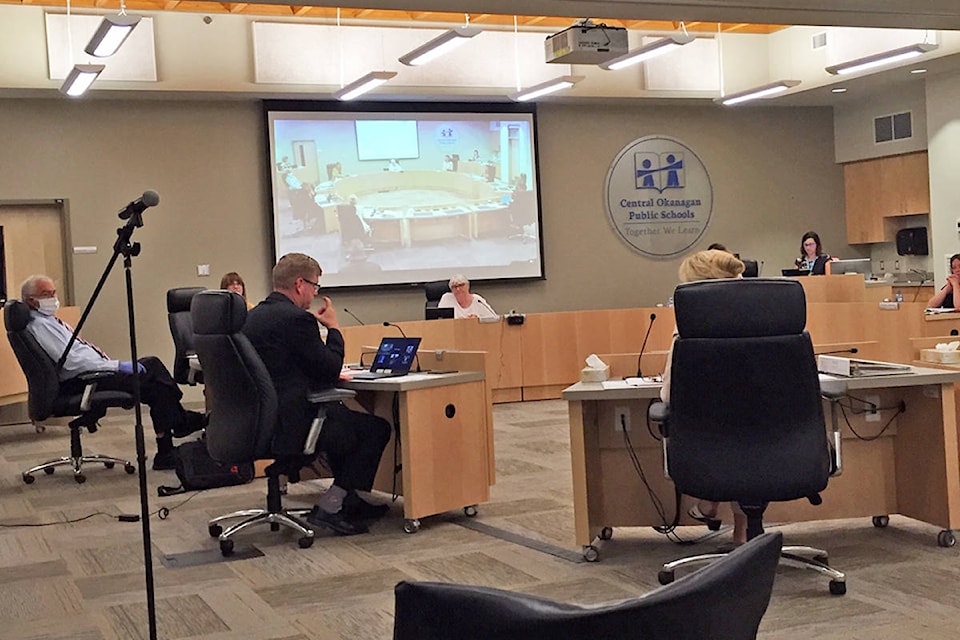Central Okanagan School District parents who choose to enrol their kids in an enhanced remote learning option this fall may lose their spot in their local catchment area school.
School board trustees backed a staff recommendation to implement the deadline in order to plan for and provide a consistent school curriculum for all students for the 2020-21 school year, particularly with the new health safety protocols in place.
At the school board meeting Wednesday evening (Sept. 2), trustees agreed students who transfer into the school or program they previously attended from the eSchoolBC remote learning program by Nov. 13, the end of the curriculum first quarter, will retain their original school spot.
Otherwise, students will be required to remain in the eSchoolBC or other distance learning option for the remainder of the 2020-21 year, and be placed as the fourth top priority for returning to their school for the 2021-22 school year.
Those coming ahead of them in the pecking order would be returning students, those who had to be placed in schools outside their catchment area and siblings of catchment area students.
With the uncertainty caused by the COVID-19 pandemic, the board decided to retain the initiative for the next two school years, and review the policy prior to the 2022-23 school year.
At this point, how many parents choose to pursue the eSchoolBC option is unclear, as is the funding to hire the teacher support the program would need if the response is overwhelming.
Kevin Kaardal, school district superintendent/CEO, told the board based on projections from feedback of school principals, the anticipation is about 90 per cent of the district’s 23,000 students will be returning to classes next week.
He said the school district is prepared to deal with that demand for remote learning registration.
READ MORE: Federal funding see as remote learning staffing option
READ MORE: Class resumption for 2020-21 school year raises challenges
Kaardal said improvements have been made to remote learning, largely reassigning existing teaching staff, to meet that eSchoolBC enrolment project, but if the numbers exceed that greatly then funding will become an issue.
The improvements include implementation of a new K-5 program, a fully synchronous middle school program (Grades 6 to 9) with an optional in-person or virtual tutorial, lessons and field studies, plus weekly synchronous tutorials and lessons to support students in Grade 10-12 core courses.
But in what has been a fluid budgeting scenario changing almost daily is expected to come to a head this week when the province releases new federal funding announced last week by Prime Minister Justin Trudeau to assist school districts across Canada.
Education Minister Rob Fleming is expected to reveal how much money will be allotted to school districts and what strings are attached and how it is spent.
The federal initiative was geared to enhancing public safety measures in schools, but in B.C. the provincial government already had provided funding to cover those needs earlier this summer.
The BC Teachers Federation has lobbied this week that the federal funding should be used to reduce school and class sizes to enable teachers, support staff and students to achieve physical distancing.
Central Okanagan Board of Education Moyra Baxter said last week that money could be spent to hire additional teachers to meet potential remote learning demands from parents.
Kaardal said he spoke with the deputy education minister earlier this week, and was given assurances that funding would be forthcoming but no commitment on how the money can or will be spent.
“There might be money set aside for staffing, but there may be some other requirements involved as well as set out by the treasury board,” Kaardal said.
“In short, it’s a positive thing that more funding will be made available, but the details are yet to be finalized.”
Kaardal also said bureaucratic red tape involving visa applications and COVID-19 could see the 400 student registration for the international student initiative be cut in half this school year, which could also have considerable financial implications for the school district.
The successful program generates revenue for the school district that has been used to support other education programs in the school district.
More than 650 people submitted questions for trustees to answer after public information meetings planned for last week had to be cancelled due to the attendance interest response, which exceeded public meeting health safety limitations.
There were also 60 questions emailed during the course of the evening.
The questions covered a myriad of issues:
- All public safety measures in schools have been approved by the ministry of education, Interior Health and provincial health authorities.
- While public gatherings are limited to 50 people, schools have been approved for student cohorts to be 60 students for elementary and 120 for secondary schools by the provincial health office. Kaardal said it’s unlikely many cohorts will reach those number maximums.
- Students won’t be required to wear masks in class but the school district has a supply of 32,000 on hand for any staff or students who wishes to wear them. Masks will be required for middle and secondary students when riding school buses.
- Parents will be alerted by school principals if their child shows COVID-19 symptoms, while IH will dictate what followup measures are required for the student and potentially affected classmates and teachers through followup tracing.
- Students placed in remote learning that relied on a school bus to get to their catchment school will be placed on a waiting list that now sits at 600 students to get another seat upon returning to their school. The bus seat will be retained if students return to classes from ESchoolBC by the Nov. 13 deadline.
